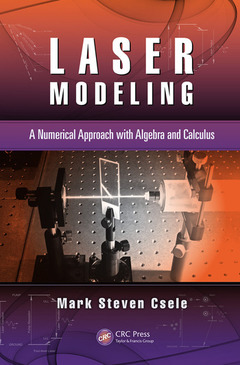Description
Laser Modeling
A Numerical Approach with Algebra and Calculus
Author: Csele Mark Steven
Language: English
Subjects for Laser Modeling:
Keywords
SHG Conversion Efficiency; Stark Splitting; HeNe Laser; Rigrod; Solid State Lasers; DPSS; Threshold Gain; Thermal Stability; Small Signal Gain; Quasi-Three-Level; Yag Laser; Gain Threshold; DPSS Laser; Simulation; Minimum Pump Power; Quasi-three Level Laser; Pump Diode; Deep Red; Gas Laser; Half Wave Voltage; Quantum Defect; Thermal Population; Phase Matching; Non-linear Coefficient; Optical Diode; Narrow Absorption Peak; Carbon Dioxide Laser; Double Pulse Laser; Laser Diode; Saturable Absorber; Laser Amplifier; Standing Wave Laser
Approximative price 96.92 €
In Print (Delivery period: 14 days).
Add to cartPublication date: 04-2017
· 15.6x23.4 cm · Paperback
Publication date: 04-2014
274 p. · 15.6x23.4 cm · Hardback
Description
/li>Contents
/li>Readership
/li>Biography
/li>
Offering a fresh take on laser engineering, Laser Modeling: A Numerical Approach with Algebra and Calculus presents algebraic models and traditional calculus-based methods in tandem to make concepts easier to digest and apply in the real world. Each technique is introduced alongside a practical, solved example based on a commercial laser. Assuming some knowledge of the nature of light, emission of radiation, and basic atomic physics, the text:
- Explains how to formulate an accurate gain threshold equation as well as determine small-signal gain
- Discusses gain saturation and introduces a novel pass-by-pass model for rapid implementation of "what if?" scenarios
- Outlines the calculus-based Rigrod approach in a simplified manner to aid in comprehension
- Considers thermal effects on solid-state lasers and other lasers with new and efficient quasi-three-level materials
- Demonstrates how the convolution method is used to predict the effect of temperature drift on a DPSS system
- Describes the technique and technology of Q-switching and provides a simple model for predicting output power
- Addresses non-linear optics and supplies a simple model for calculating optimal crystal length
- Examines common laser systems, answering basic design questions and summarizing parameters
- Includes downloadable Microsoft® Excel? spreadsheets, allowing models to be customized for specific lasers
Don?t let the mathematical rigor of solutions get in the way of understanding the concepts. Laser Modeling: A Numerical Approach with Algebra and Calculus covers laser theory in an accessible way that can be applied immediately, and numerically, to real laser systems.
Basic Laser Processes. Threshold Gain. Gain Saturation. Analytical Solutions. Thermal Issues. Generating Massive Inversions: Q-Switching. Non-Linear Optics. Common Lasers and Parameters.
Mark Steven Csele is a full-time professor at Niagara College, Welland, Ontario, Canada. A physicist and professional engineer, he has taught for over 20 years at levels ranging from two-year technician to four-year undergraduate. Currently, he teaches photonics at Niagara College, which features an array of dedicated laboratories hosting a variety of laser systems. He has authored a previous book on fundamental laser concepts as well as several articles in magazines and trade encyclopedias.
These books may interest you

Laser in Manufacturing 178.13 €



